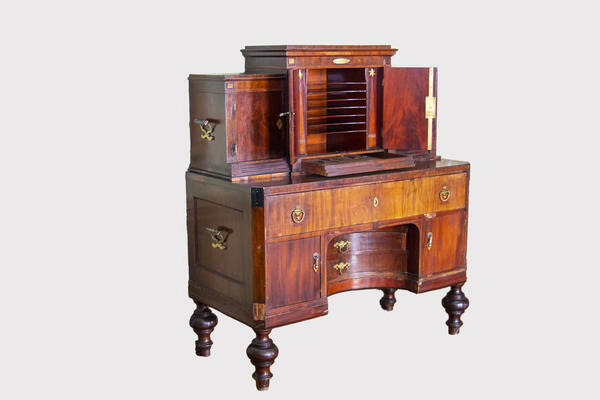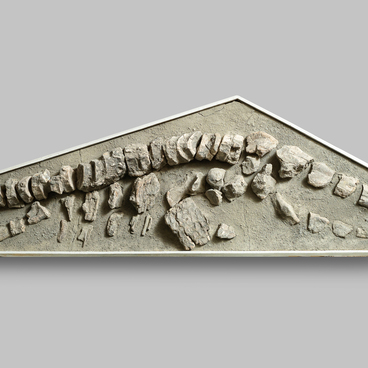The Volsk Museum of Local History displays a two-tiered rectangular secretaire made of dark stained wood in the early 19th century. It is lacquered, the drawers have decorative brass plates and metal handles.
The secretaire is veneered. This was the furniture decoration process when the master covered a cheap wooden base with thin sheets of fine wood — veneer.
Secretaires as a special type of furniture appeared in the 18th century, though some researchers date them back to the 12th –13th centuries. Secretaires were usually small cabinets with drawers and shelves for storing papers. Sometimes, a sliding tray or a flap which was used as a desk was attached to them.
A secretaire was similar to a bureau — a desk which was equipped with added shelves and drawers and a special lid covering the work area. However, unlike a bureau, a secretaire had many secret drawers and mechanisms which helped its owner to protect securities and mail.
The first secretaire was made in 1730. At that time, it was called ‘ladies’ furniture’: it was a small filing cabinet with a folding table for writing letters. The sides were decorated with shaped panels and carving. Only ladies of high society could afford such secretaires. They kept jewelry in drawers and potions and perfume on the shelves.
Later, secretaires became bigger, with more drawers. They began to be installed in workrooms and used to store securities and business correspondence. Locks and other latching mechanisms helped to keep important documents from prying eyes. In the 1750s, the first secret locks and mechanisms appeared in the secretaires, which were made by the mechanic and watchmaker Peter Kinzing. Thus, one secretaire replaced a desk, a safe, and a cabinet.
Secretaires could be both large and miniature. There are records of Napoleon’s travel secretaire: it was very small when folded and could be easily assembled into numerous drawers that could fit many documents and a writing set. According to the memoirs of contemporaries, this secretaire could be used to set up a desk even on the battlefield.
The secretaire is veneered. This was the furniture decoration process when the master covered a cheap wooden base with thin sheets of fine wood — veneer.
Secretaires as a special type of furniture appeared in the 18th century, though some researchers date them back to the 12th –13th centuries. Secretaires were usually small cabinets with drawers and shelves for storing papers. Sometimes, a sliding tray or a flap which was used as a desk was attached to them.
A secretaire was similar to a bureau — a desk which was equipped with added shelves and drawers and a special lid covering the work area. However, unlike a bureau, a secretaire had many secret drawers and mechanisms which helped its owner to protect securities and mail.
The first secretaire was made in 1730. At that time, it was called ‘ladies’ furniture’: it was a small filing cabinet with a folding table for writing letters. The sides were decorated with shaped panels and carving. Only ladies of high society could afford such secretaires. They kept jewelry in drawers and potions and perfume on the shelves.
Later, secretaires became bigger, with more drawers. They began to be installed in workrooms and used to store securities and business correspondence. Locks and other latching mechanisms helped to keep important documents from prying eyes. In the 1750s, the first secret locks and mechanisms appeared in the secretaires, which were made by the mechanic and watchmaker Peter Kinzing. Thus, one secretaire replaced a desk, a safe, and a cabinet.
Secretaires could be both large and miniature. There are records of Napoleon’s travel secretaire: it was very small when folded and could be easily assembled into numerous drawers that could fit many documents and a writing set. According to the memoirs of contemporaries, this secretaire could be used to set up a desk even on the battlefield.



